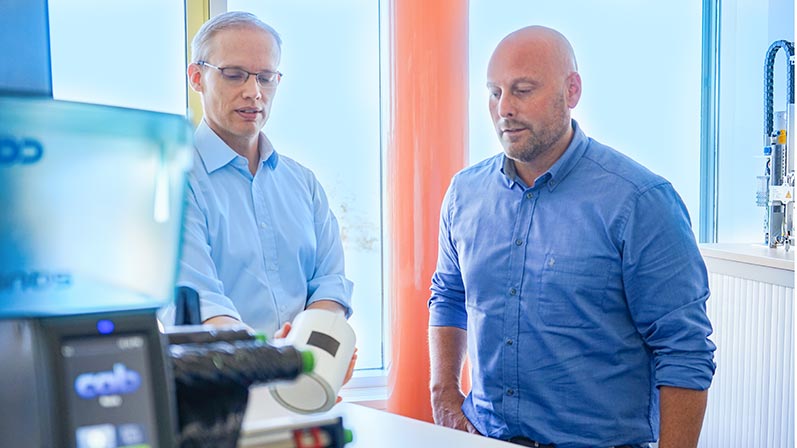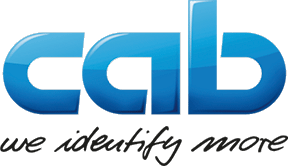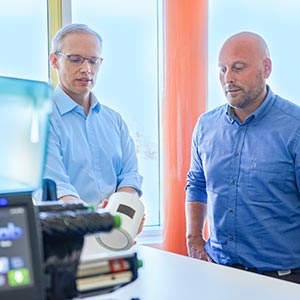How to schedule label printing

- cab’s editorial staff in a talk with Marc Thelen (Development dept.) and Heiko Weber (Consumables)
Within a value chain, each activity imposes conditions. In terms of label printing however, one key issue remains basically the same: the information printed must be displayed entirely, correct and clearly legible. Which printer is the right one?
Thelen: This can hardly be answered in general terms. In principle, any thermal, inkjet or laser printer is capable of printing labels. To make the perfect choice, the application must be evaluated. Amongst others, the place of work, print volumes, resistances and durabilities required of labels and their imprints must be taken into account. With regard to quality, reliability and safety, the common printing methods meet different levels of demand.
cab develops and produces thermal transfer printers. On these, a special ribbon is heated by the print head on specific spots. The color layer of the ribbon melts and transfers to the material to print. How does this method benefit label printing?
Thelen: The main advantage is the high efficiency.
How is this justified?
Thelen: cab printers pick up label rolls. These make flexible if you want to print larger quantities or individual labels. It is not necessary to provide label sheets again and again. Waste is reduced. Thermal printing eliminates standby times demanded for colors drying, enabling very high print speeds. 300 mm/s are possible using a cab printer. Even several thousand labels can be printed per day in continuous operation.

- Heiko Weber, Consumables
Weber: Many of our customers demand high quality imprints. Products may be traced to their origin by specific codes or individual batch numbers. To verify small fonts by looking and tiny codes with scanners, printable resolutions up to 600 dpi, high contrast and sharp-edged imprints are required. Thermal transfer printing can do this.
What about the durability of such markings?
Weber: Using thermal transfer printing, possible applications range from variable data markings and barcode labels to typeplates, safety, warning, address or shipping labels. In particular in the automotive, chemical and pharmaceutical industries, labeled goods are exposed to liquids, solvents or chemicals. In electronics, temperatures rise to several hundred degrees while components are soldered on PCBs. In labs, labeled samples are preserved at temperatures as low as minus 196 °C in liquid nitrogen. Provided that proper materials have been used, thermal imprints remain legible on goods during processing, testing, picking, storage and transport. On this, we offer our customers long-term experience.
Why not use ink or laser?
Thelen: As mentioned earlier on, this can hardly be answered in general terms. Each label application is unique. If, for example, no pigmented ink is used, markings may smear when touched or exposed to water or solvents. Laser printings do not smear. However, the intense heat generated by such printers does not comply with labels using adhesives.
Weber: By the way, we also recommend using sufficient label quality when printing in thermal transfer method. If, for example, adhesive permanently leaks from the margins of labels, this can affect their removability from the liner material. Or labels may stick to components on a printer, causing malfunctions.
cab devices are known for their longevity. Marc, how do you personally perceive the development of our devices, from understanding wishes articulated by customers to a product ready for serial production?
Thelen: I joined cab one year and two months ago. This is not such a long time yet. Nevertheless, I can say that most of our customers are aware that we do not just provide them a printer. We accelerate process times, simplify operations, integrate products exactly to information systems and pay visits on site to understand requirements exactly. Longevity often plays a key role here. Many customers are now having a cab printer in continuous use for 20 or more years.
Are our printers a future-proof investment?
Thelen: I do not know a label printer manufacturer other than cab acting as quick and flexible when it comes to new market requirements. If a product to label or a label changes, the equipment can be adapted in an instant. Mechanically, we provide the most comprehensive range of peripherals on the market. Furthermore, many cab devices are built upon the same components. User companies benefit from minimal spare parts handling, as well as low inventory and service costs.
What makes our electronics that successful?
Thelen: All our current printers are based on the same electronics and firmware. The printer language is the same, so are the interfaces. Any further developed operating system or driver is available immediately on every device. At present, no other manufacturer can offer this. All these components clever interacting results in very quick processing times.
Please introduce three such features briefly.

- Marc Thelen, Development
Thelen: As the manager of our development department, I pay attention to details. I could spontaneously think of much more things worth mentioning. With regard to a maximum of three features, I definitely include the slim programming language Jscript. The ABC BASIC Compiler is another. It allows programming a printer before data are edited for processing. With the help of the WebDAV transfer protocol, virtual memories can be integrated to cab devices via a network. The web memory can thus be accessed as a drive anywhere.
Is connectivity an issue in the planning of label printing?
Thelen: I assume digital work processes be operated in most of the companies. Modern manufacture sees systems work autonomous, interact among each other, with host computers or a plant control unit. For higher-wage countries in particular it is decisive to have value added processes and an optimized management of resources. My own personal experience is that networking has modified specification profiles in manufacture or warehousing. Changes will continue, this much is sure.
May cab printers be called networkers?
Thelen: For sure! Connectivity plays a major role in our development activities. cab printers provide all the required interfaces. To transfer data via OPC UA, the firmware integrates a server and a client. The server enables a printer be configured and controlled. Dynamic print data can be edited using a defined programming interface. Data fields from other machines ready for OPC UA can be read using the client, as well as data be transferred to a label.
Data nowadays are considered a raw material. To what extent can these data be protected?
Thelen: Solutions on this task are also an integral part of our product development. cab printers provide proper features to protect data in a network. Permissions can be assigned to users and restricted by passwords, USB slots and access to external storage media be locked, WLAN and Bluetooth be switched on or off. Access to network services such as HTTP, FTP or VNC is possible only for users with authorization. Network protocols can be encrypted using TLS/SSL, WPA2 and WPA2 Enterprise levels of security are supported. Firmware updates are verified for integrity before installation. To connect securely in a network, a certificate as required is installed in a printer ex factory.
Reliable processes may be a sales argument also with consumables.
Weber: They are! Even a crucial one! By means of structured methods, customer demands in the matters of processes and its approvals can be represented and successfully realized. As regards labels, we operate according to IATF 16949. On this occasion, we offer structured sampling as far as PPAP. cab quality management complies with the international ISO 9001:2015 standard and has been adapted to high level structure.
If a cab printer is in use: Why is it beneficial to obtain also labels from cab?
Weber: You definitely increase productivity. The label surfaces have been optimized for thermal transfer printing, enabling high-resoluted imprints. The rolls and core diameters correspond to cab printers, so do the windings. We provide a wide range of suitable label materials ex stock and are able to deliver immediately.
What about the ribbons?
Weber: All our ribbons in resin, wax or wax/resin mixture qualities dissipate heat in an optimum way, protecting the print head. A special backcoating prevents from friction respectively electrostatic charge. This supports extended print head life.
Let's conclude our talk by referring label printing to the food industry. Here, data on labels can decide whether a product is carried by a consumer to the checkout or returned to a shelf.
Weber: Indeed, food is a complex field of application. With regard to goods and products be identified and traceable, high standards have to be met. Information includes ingredients, nutritional values or allergens, prices, quantities, shelf life or origins. All these must be displayed visible, clearly legible and resistant to water on a label.
Thelen: Formulas or filling quantities can change. Or actions are limited to time or regions. Then things must be put into practice and implemented on labels at short notice. Our thermal transfer printers enable a labeling process be changed quickly and economically. Operations continue without interruptions or downtimes related to the printer.
September 2020

